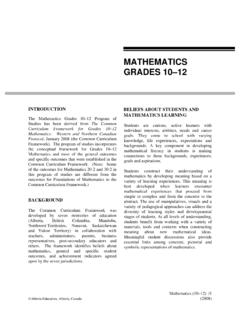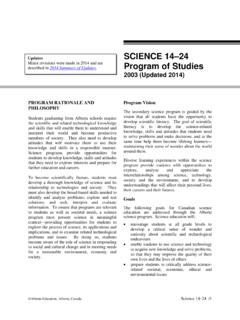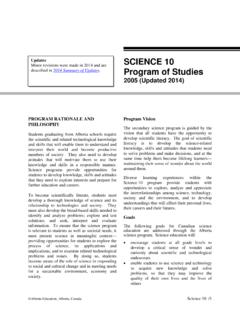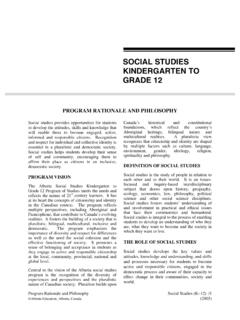Transcription of MATHEMATICS KINDERGARTEN TO GRADE 9 - Alberta
1 MATHEMATICS (K 9) /1 Alberta Education, Alberta , Canada 2007 (Updated 2016) INTRODUCTION The MATHEMATICS KINDERGARTEN to GRADE 9 Program of Studies has been derived from The Common Curriculum Framework for K 9 MATHEMATICS : Western and Northern Canadian Protocol, May 2006 (the Common Curriculum Framework). The program of studies incorporates the conceptual framework for KINDERGARTEN to GRADE 9 MATHEMATICS and the general outcomes and specific outcomes that were established in the Common Curriculum Framework. BACKGROUND The Common Curriculum Framework was developed by the seven ministries of education ( Alberta , British Columbia, Manitoba, Northwest Territories, Nunavut, Saskatchewan and Yukon Territory) in collaboration with teachers, administrators, parents, business representatives, post-secondary educators and others.
2 The framework identifies beliefs about MATHEMATICS , general and specific student outcomes, and achievement indicators agreed upon by the seven jurisdictions. BELIEFS ABOUT STUDENTS AND MATHEMATICS LEARNING Students are curious, active learners with individual interests, abilities and needs. They come to classrooms with varying knowledge, life experiences and backgrounds. A key component in successfully developing numeracy is making connections to these backgrounds and experiences. Students learn by attaching meaning to what they do, and they need to construct their own meaning of MATHEMATICS . This meaning is best developed when learners encounter mathematical experiences that proceed from the simple to the complex and from the concrete to the abstract. Through the use of manipulatives and a variety of pedagogical approaches, teachers can address the diverse learning styles, cultural backgrounds and developmental stages of students, and enhance within them the formation of sound, transferable mathematical understandings.
3 At all levels, students benefit from working with a variety of materials, tools and contexts when constructing meaning about new mathematical ideas. Meaningful student discussions provide essential links among concrete, pictorial and symbolic representations of mathematical concepts. The learning environment should value and respect the diversity of students experiences and ways of thinking, so that students are comfortable taking intellectual risks, asking questions and posing conjectures. Students need to explore problem-solving situations in order to develop personal strategies and become mathematically literate. They must realize that it is acceptable to solve problems in a variety of ways and that a variety of solutions may be acceptable. MATHEMATICS KINDERGARTEN TO GRADE 9 2/ MATHEMATICS (K 9) 2007 (Updated 2016) Alberta Education, Alberta , Canada FIRST NATIONS, M TIS AND INUIT PERSPECTIVES First Nations, M tis and Inuit students in northern and western Canada come from diverse geographic areas with varied cultural and linguistic backgrounds.
4 Students attend schools in a variety of settings, including urban, rural and isolated communities. Teachers need to understand the diversity of students cultures and experiences. First Nations, M tis and Inuit students often have a holistic view of the environment they look for connections in learning and learn best when MATHEMATICS is contextualized. They may come from cultures where learning takes place through active participation. Traditionally, little emphasis was placed upon the written word, so oral communication and practical applications and experiences are important to student learning and understanding. By understanding and responding to nonverbal cues, teachers can optimize student learning and mathematical understanding. A variety of teaching and assessment strategies help build upon the diverse knowledge, cultures, communication styles, skills, attitudes, experiences and learning styles of students.
5 Research indicates that when strategies go beyond the incidental inclusion of topics and objects unique to a culture or region, greater levels of understanding can be achieved (Banks and Banks, 1993). AFFECTIVE DOMAIN A positive attitude is an important aspect of the affective domain and has a profound impact on learning. Environments that create a sense of belonging, encourage risk taking and provide opportunities for success help develop and maintain positive attitudes and self-confidence within students. Students with positive attitudes toward learning MATHEMATICS are likely to be motivated and prepared to learn, participate willingly in classroom activities, persist in challenging situations and engage in reflective practices. Teachers, students and parents need to recognize the relationship between the affective and cognitive domains, and attempt to nurture those aspects of the affective domain that contribute to positive attitudes.
6 To experience success, students must be taught to set achievable goals and assess themselves as they work toward these goals. Striving toward success and becoming autonomous and responsible learners are ongoing, reflective processes that involve revisiting the setting and assessing of personal goals. EARLY CHILDHOOD Young children are naturally curious and develop a variety of mathematical ideas before they enter KINDERGARTEN . Children make sense of their environment through observations and interactions at home, in daycares, in preschools and in the community. MATHEMATICS learning is embedded in everyday activities, such as playing, reading, beading, baking, storytelling and helping around the home. Activities can contribute to the development of number and spatial sense in children. Curiosity about MATHEMATICS is fostered when children are engaged in, and talking about, such activities as comparing quantities, searching for patterns, sorting objects, ordering objects, creating designs and building with blocks.
7 Positive early experiences in MATHEMATICS are as critical to child development as are early literacy experiences. GOALS FOR STUDENTS The main goals of MATHEMATICS education are to prepare students to: use MATHEMATICS confidently to solve problems communicate and reason mathematically appreciate and value MATHEMATICS make connections between MATHEMATICS and its applications MATHEMATICS (K 9) /3 Alberta Education, Alberta , Canada 2007 (Updated 2016) commit themselves to lifelong learning become mathematically literate adults, using MATHEMATICS to contribute to society. Students who have met these goals will: gain understanding and appreciation of the contributions of MATHEMATICS as a science, philosophy and art exhibit a positive attitude toward MATHEMATICS engage and persevere in mathematical tasks and projects contribute to mathematical discussions take risks in performing mathematical tasks exhibit curiosity.
8 4/ MATHEMATICS (K 9) 2007 (Updated 2016) Alberta Education, Alberta , Canada CONCEPTUAL FRAMEWORK FOR K 9 MATHEMATICS The chart below provides an overview of how mathematical processes and the nature of MATHEMATICS influence learning outcomes. Achievement indicators for the prescribed program of studies outcomes are provided in the companion document Alberta K 9 MATHEMATICS Achievement Indicators, 2016. Mathematical Processes There are critical components that students must encounter in a MATHEMATICS program in order to achieve the goals of MATHEMATICS education and embrace lifelong learning in MATHEMATICS . Students are expected to: Communication [C] Connections [CN] Mental MATHEMATICS and Estimation [ME] Problem Solving [PS] Reasoning [R] Technology [T] Visualization [V] communicate in order to learn and express their understanding connect mathematical ideas to other concepts in MATHEMATICS , to everyday experiences and to other disciplines demonstrate fluency with mental MATHEMATICS and estimation develop and apply new mathematical knowledge through problem solving develop mathematical reasoning select and use technologies as tools for learning and for solving problems develop visualization skills to assist in processing information, making connections and solving problems.
9 The program of studies incorporates these seven interrelated mathematical processes that are intended to permeate teaching and learning. Number Patterns and Relations Patterns Variables and Equations Shape and Space Measurement 3-D Objects and 2-D Shapes Transformations Statistics and Probability Data Analysis Chance and Uncertainty GENERAL OUTCOMES AND SPECIFIC OUTCOMES GRADE STRAND K 1 2 3 4 5 6 7 8 9 NATURE OF MATHEMATICS Change, Constancy, Number Sense, Patterns, Relationships, Spatial Sense, Uncertainty MATHEMATICAL PROCESSES Communication, Connections, Mental MATHEMATICS and Estimation, Problem Solving, Reasoning, Technology, Visualization MATHEMATICS (K 9) /5 Alberta Education, Alberta , Canada 2007 (Updated 2016) COMMUNICATION [C] Students need opportunities to read about, represent, view, write about, listen to and discuss mathematical ideas. These opportunities allow students to create links between their own language and ideas, and the formal language and symbols of MATHEMATICS .
10 Communication is important in clarifying, reinforcing and modifying ideas, attitudes and beliefs about MATHEMATICS . Students should be encouraged to use a variety of forms of communication while learning MATHEMATICS . Students also need to communicate their learning using mathematical terminology. Communication helps students make connections among concrete, pictorial, symbolic, oral, written and mental representations of mathematical ideas. CONNECTIONS [CN] Contextualization and making connections to the experiences of learners are powerful processes in developing mathematical understanding. This can be particularly true for First Nations, M tis and Inuit learners. When mathematical ideas are connected to each other or to real-world phenomena, students begin to view MATHEMATICS as useful, relevant and integrated.









